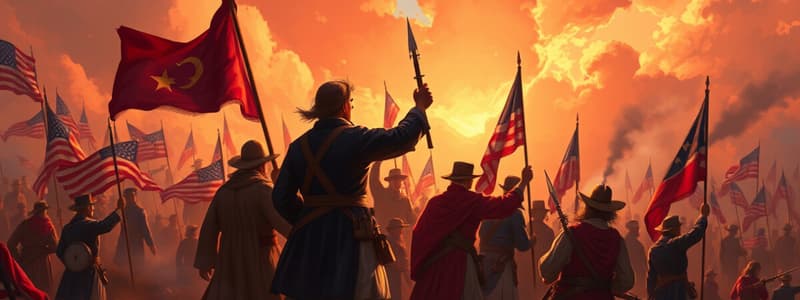Podcast
Questions and Answers
Which statement best describes unalienable rights as presented in the Declaration of Independence?
Which statement best describes unalienable rights as presented in the Declaration of Independence?
- They are earned through civic duty and participation.
- They are granted and protected by the government.
- They are privileges granted based on citizenship.
- They are inherent to all individuals and cannot be taken away. (correct)
What was the primary intention of Thomas Paine's 'Common Sense'?
What was the primary intention of Thomas Paine's 'Common Sense'?
- To promote reconciliation with Britain.
- To advocate for stronger ties with European nations.
- To convince colonists to gain independence from Britain. (correct)
- To highlight the advantages of British governance.
What did the Lee Resolution declare?
What did the Lee Resolution declare?
- The colonies' desire for reconciliation with Britain.
- The colonies' independence from British rule. (correct)
- The colonies' intention to join forces with Native Americans.
- The colonies' intention to form a government.
Which section of the Declaration of Independence addresses grievances against the king?
Which section of the Declaration of Independence addresses grievances against the king?
Which of the following best describes civil rights as defined in the Bill of Rights?
Which of the following best describes civil rights as defined in the Bill of Rights?
In the context of West African culture, what was considered the most noble of jobs?
In the context of West African culture, what was considered the most noble of jobs?
What characterizes the 'Middle Passage' in the enslavement process?
What characterizes the 'Middle Passage' in the enslavement process?
What was a significant impact of enslavement on West Africans?
What was a significant impact of enslavement on West Africans?
Which argument did Thomas Paine NOT make in 'Common Sense'?
Which argument did Thomas Paine NOT make in 'Common Sense'?
What key concept is embodied in the statement, 'All men are created equal'?
What key concept is embodied in the statement, 'All men are created equal'?
Flashcards are hidden until you start studying
Study Notes
Rights in the United States
- Unalienable Rights originate from the Declaration of Independence, given at birth, including equality, life, liberty, and the pursuit of happiness.
- Civil Rights, detailed in the Bill of Rights, are granted and protected by the government and include freedoms such as speech, press, religion, assembly, petition, and the right to vote.
Common Sense, January 1776
- Thomas Paine wrote "Common Sense" to persuade colonists to seek independence from Britain.
- Key arguments include:
- Colonists can thrive independently of British rule.
- Britain's motives are driven by financial gain.
- The absurdity of a small island governing a vast continent.
- Urgency in declaring independence while the possibility exists.
Lee Resolution - Adopted July 2, 1776
- The Lee Resolution officially declared independence from Britain.
- It stated that the United Colonies are free and independent states, absolved from allegiance to the British Crown.
Declaration of Independence - Adopted July 4, 1776
- Authored primarily by Thomas Jefferson and created by the Committee of Five to justify rebellion against Britain.
- Contains several sections:
- Preamble: Affirms human equality and unalienable rights of life, liberty, and the pursuit of happiness.
- List of King's Crimes: Identifies grievances against King George III, including taxation without consent.
- Statement of Independence: Proclaims the colonies' severance from British rule.
- Incorporates the principles of the Lee Resolution.
West African Culture
- Encompasses an area of 12 million square miles, capable of containing the USA, Europe, China, and India.
- Societal structure revolves around farming and familial bonds, prioritizing people over material possessions.
- Agriculture regarded as the most honorable profession; music, especially drumming, plays a crucial role in cultural expression.
Passages into Enslavement
- First Passage: Involves the capture of individuals and transport to the coast, leading to branding as chattel (property).
- Middle Passage: Refers to the grueling voyage on slave ships from West Africa to the Americas, characterized by tight or loose packing methods.
- Third Passage: The slave auction process where individuals are sold to the highest bidder.
- An estimated 12 to 30 million West Africans were enslaved, with the system being permanent, race-based, and denying rights.
- Enslaved people were pressured to abandon their cultural identities, leading to family separation but preservation of traditions like dance and storytelling.
Studying That Suits You
Use AI to generate personalized quizzes and flashcards to suit your learning preferences.


